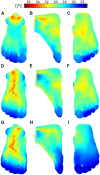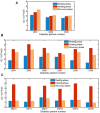Thermal Analysis of Blood Flow Alterations in Human Hand and Foot Based on Vascular-Porous Media Model
- PMID: 35155402
- PMCID: PMC8831761
- DOI: 10.3389/fbioe.2021.786615
Thermal Analysis of Blood Flow Alterations in Human Hand and Foot Based on Vascular-Porous Media Model
Abstract
Microvascular and Macrovascular diseases are serious complications of diabetic mellitus, which significantly affect the life quality of diabetic patients. Quantitative description of the relationship between temperature and blood flow is considerably important for non-invasive detection of blood vessel structural and functional lesions. In this study, thermal analysis has been employed to predict blood flow alterations in a foot and a cubic skin model successively by using a discrete vessel-porous media model and further compared the blood flows in 31 diabetic patients. The tissue is regarded as porous media whose liquid phase represents the blood flow in capillaries and solid phase refers to the tissue part. Discrete vascular segments composed of arteries, arterioles, veins, and venules were embedded in the foot model. In the foot thermal analysis, the temperature distributions with different inlet vascular stenosis were simulated. The local temperature area sensitive to the reduction of perfusion was obtained under different inlet blood flow conditions. The discrete vascular-porous media model was further applied in the assessment of the skin blood flow by coupling the measured skin temperatures of diabetic patients and an inverse method. In comparison with the estimated blood flows among the diabetic patients, delayed blood flow regulation was found in some of diabetic patients, implying that there may be some vascular disorders in these patients. The conclusion confirms the one in our previous experiment on diabetic rats. Most of the patients predicted to be with vascular disorders were diagnosed as vascular complication in clinical settings as well, suggesting the potential applications of the vascular-porous media model in health management of diabetic patients.
Keywords: blood flow estimation; diabetic foot; porous media model; thermal analysis; vascular disorder.
Copyright © 2022 Wang, Cheng, He and Mu.
Conflict of interest statement
The authors declare that the research was conducted in the absence of any commercial or financial relationships that could be construed as a potential conflict of interest.
Figures












Similar articles
-
Heat transfer analysis of blood perfusion in diabetic rats using a genetic algorithm.Microvasc Res. 2020 Sep;131:104013. doi: 10.1016/j.mvr.2020.104013. Epub 2020 May 16. Microvasc Res. 2020. PMID: 32428521
-
Three-dimensional interactions of mean body and local skin temperatures in the control of hand and foot blood flows.Eur J Appl Physiol. 2014 Aug;114(8):1679-89. doi: 10.1007/s00421-014-2894-x. Epub 2014 May 14. Eur J Appl Physiol. 2014. PMID: 24819447
-
The relationship of laser-Doppler skin blood flow measurements to the cutaneous microvascular anatomy.Microvasc Res. 1998 Jan;55(1):3-13. doi: 10.1006/mvre.1997.2049. Microvasc Res. 1998. PMID: 9473405
-
Why critical limb ischemia criteria are not applicable to diabetic foot and what the consequences are.Scand J Surg. 2012;101(2):114-8. doi: 10.1177/145749691210100207. Scand J Surg. 2012. PMID: 22623444 Review.
-
Effects of C-peptide on microvascular blood flow and blood hemorheology.Exp Diabesity Res. 2004 Jan-Mar;5(1):51-64. doi: 10.1080/15438600490424532. Exp Diabesity Res. 2004. PMID: 15198371 Free PMC article. Review.
Cited by
-
Skin Microhemodynamics and Mechanisms of Its Regulation in Type 2 Diabetes Mellitus.Biophysics (Oxf). 2022;67(4):647-659. doi: 10.1134/S0006350922040200. Epub 2022 Oct 19. Biophysics (Oxf). 2022. PMID: 36281313 Free PMC article.
-
In-shoe plantar temperature, normal and shear stress relationships during gait and rest periods for people living with and without diabetes.Sci Rep. 2025 Mar 14;15(1):8804. doi: 10.1038/s41598-025-91934-9. Sci Rep. 2025. PMID: 40087292 Free PMC article.
-
Flexible thin-film thermal sensor for estimating thermal transport properties designed for biomaterial applications.Sci Rep. 2025 May 28;15(1):18648. doi: 10.1038/s41598-025-03304-0. Sci Rep. 2025. PMID: 40437190 Free PMC article.
-
Modeling a 3-D multiscale blood-flow and heat-transfer framework for realistic vascular systems.Sci Rep. 2022 Aug 26;12(1):14610. doi: 10.1038/s41598-022-18831-3. Sci Rep. 2022. PMID: 36028657 Free PMC article.
-
Molecular mechanism and intervention measures of microvascular complications in diabetes.Open Med (Wars). 2024 Apr 17;19(1):20230894. doi: 10.1515/med-2023-0894. eCollection 2024. Open Med (Wars). 2024. PMID: 38645437 Free PMC article. Review.
References
-
- Astasio A., Escamilla M. E., Martínez N., Sánchez Rodríguez R., Gómez–Martín B. (2018). Thermal Map of the Diabetic Foot Using Infrared Thermography. Infrared Phys. Techn. 93, S1350449518302512. 10.1016/j.infrared.2018.07.008 - DOI
LinkOut - more resources
Full Text Sources

